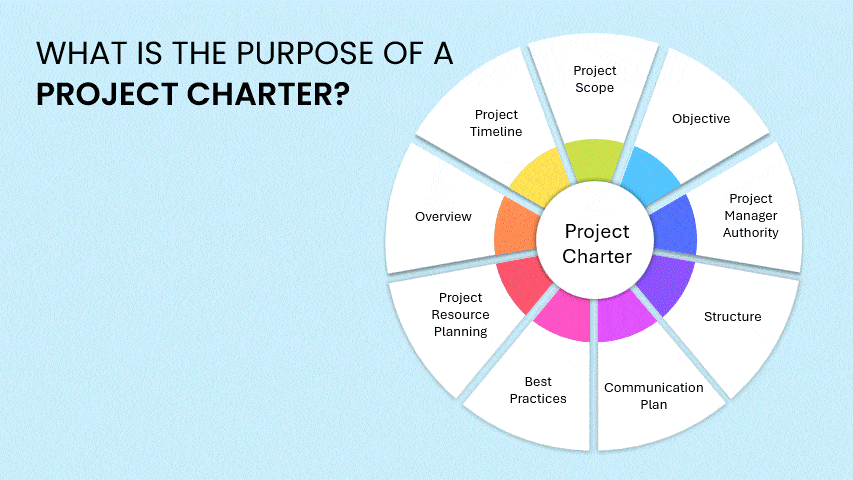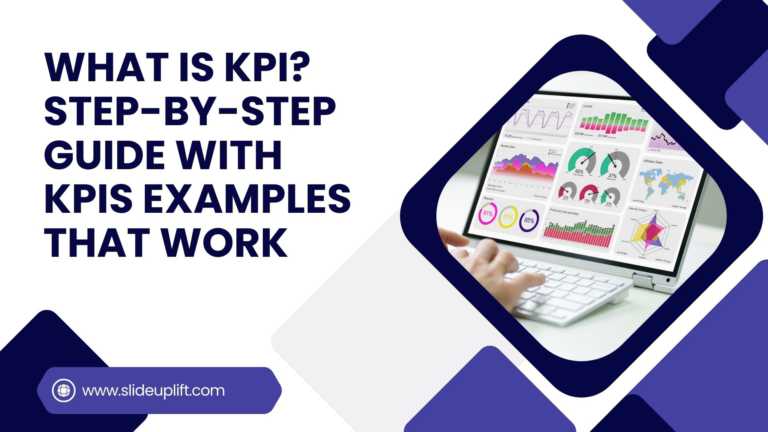What Is A Project Charter? Definition, Examples & Best Practices
Launching a project without adequate planning can result in confusion, delays, and misaligned expectations. A project charter is a key document in the project documentation process that lays the groundwork for any project. A project charter defines the project’s purpose, objectives, scope, stakeholders, and authority. The clear delineation of project purpose and direction ensures that all participants understand and have clear boundaries from the beginning.
Developing a project charter will also assist in obtaining stakeholder buy-in, assigning responsibilities, and establishing criteria to measure success. Best practice supports all of those principles through either creating the project charter itself or writing the project charter in numerical detail and conducting benefit/cost analysis. Additionally, establishing a high-level risk management plan can enhance clarity of purpose and alignment throughout the duration of the project. In this blog, we will define what is a project charter, discuss the importance and value of a project charter, and provide examples from an ‘everyone’ perspective as we construct (develop) a project charter with an effective or efficient methodology.
What Is A Project Charter?
A project charter is a formal document that describes the purpose and targets of a project, including the project objectives. The charter specifies what a project intends to accomplish and why it is being undertaken. It highlights the primary stakeholders and scopes the project.
The project charter provides the project manager with limited authority to utilize resources and direct the project team. The project charter is created during initiation and serves as a living reference for the project management plan throughout the life of the project. The project charter ensures early shared understanding of direction.
What Is The Purpose Of A Project Charter?
A project charter starts the project of turning an idea into reality, defining the major milestones. It articulates a solid foundation for the project to ensure everyone is on the same page about the project’s purpose and direction.
- Sets project goals: It describes the stated purpose of the project and why that matters.
- Establishes authorization: It provides the project manager with official authority to start and influence the project.
- Brings stakeholder alignment: It allows the stakeholders to understand the explained objectives and expectations.
- Sets project limits: It describes the project scope of a project and explains what the project and its scope will and will not include.
- Provides a reference document: It can be referenced throughout the project to keep the project on track.
- Designates accountability: it highlights key stakeholders and their roles.
- Facilitates approval: Its documented plan can be more readily presented to and approved by sponsors so that stakeholders can proceed with the vendor/consultant job performance.
In summary, a well-written project charter is a pathway towards success. It provides a path toward clarity, alignment, and authorization for every project endeavor in mind at the beginning stage.
How To Write A Project Charter?
Creating a project charter involves several key steps to ensure the document is complete, clear, and effective. Here’s a step-by-step guide to the charter of the project, including identifying potential project risks:
- Identify the Project Purpose: Start by explaining why the project is being initiated. Describe the problem or opportunity it aims to address and how it aligns with organizational goals.
- Define Project Objectives: Clearly state what the project aims to achieve. Objectives should be specific, measurable, achievable, relevant, and time-bound (SMART).
- Outline the Project Scope and scope management: Define what is included in the project and what is not. This helps prevent misunderstandings and keeps the project focused.
- List Key Stakeholders: Identify individuals or groups who have an interest in the project. Include their roles, responsibilities, and level of involvement in the communication plan.
- Appoint a Project Manager: Mention the project manager’s name and authority. Specify what decisions they can make and how they will lead the team.
- Estimate Budget and Resources: Include an overview of the financial and resource requirements needed to complete the project successfully, highlighting key information for budget allocation.
- Estimate Budget and Resources: Include an overview of the financial and resource requirements needed to complete the project successfully.
- Identify Risks and Constraints: Highlight possible and overcoming challenges or limitations, including potential risks, that could affect the project’s progress.
- Define Success Criteria: Explain how project success will be measured, such as performance metrics, deadlines, or quality standards.
- Get Sponsor Approval: Once the charter is drafted, share it with the project sponsor for review and approval. Their signature officially authorizes the project to begin.
Creating a project charter is the first step toward organized project management. By clearly defining goals, roles, and expectations, it ensures everyone is aligned and ready to move forward confidently. Once completed, your project charter can be presented in a project presentation to align all stakeholders.
Why Do You Need A Project Charter?
Many people wonder if every project really needs a project charter. The answer is yes—especially if you want a clear understanding of the project, clarity, structure, and stakeholder alignment from the start.
Do You Need a Project Charter?
- Provides clear direction: It defines the project’s goals and purpose before work begins.
- Establishes authority: It officially empowers the project manager to lead the team.
- Ensures stakeholder alignment: Everyone understands their roles and the project’s objectives.
- Reduces confusion: It sets boundaries, preventing scope creep and misunderstandings among the project team members.
- Supports decision-making: It helps sponsors evaluate progress and approve major changes.
- Acts as a reference guide: It keeps the team focused on agreed goals throughout the project.
A project charter might seem simple, but it’s the foundation of project success. It turns ideas into actionable plans with clear ownership and direction.
What Are The Different Project Charter Examples?
Project charters can vary depending on the type and goals of a project. The table below shows project charter examples across different industries, highlighting objectives, scope, stakeholders, and success criteria.
| Project Type | Project Title | Objectives | Scope | Key Stakeholders | Success Criteria |
| Marketing | Product Launch Campaign | Increase brand awareness and sales | Social media ads, events, and marketing materials | Marketing Manager, Sales Team | 25% website traffic increase, 15% sales growth |
| IT/Software | CRM System Implementation | Improve customer data management | Install CRM software, train staff, and migrate data | IT Manager, Sales Team, Employees | 100% staff trained, data migrated without errors |
| Construction | Office Renovation | Upgrade office infrastructure | Renovate workspace, upgrade furniture and lighting | Facilities Manager, Employees, Contractors | Project completed on time, within budget |
| Event Management | Annual Conference | Host a successful conference | Venue booking, speakers, marketing, and attendee registration | Event Manager, Sponsors, Speakers | 500 attendees, positive feedback from 90% of participants |
| Research/Development | New Product R&D | Develop a prototype for market testing | Research, design, prototype creation | R&D Team, Product Manager | Prototype ready within 6 months, meets design criteria |

These Project charter examples illustrate how a well-structured project charter clearly defines project direction. They provide a practical reference for creating your own charter efficiently.
Who Should Write A Project Charter?
Writing a project charter is typically one of the first steps in any project management process; however, who writes the document?
- Project Manager: Most often leads the way in drafting the charter to define the project details accurately.
- Project Sponsor: Inputs on goals, funding, and business reasons, reviews, and approves a final version of the charter.
- Key Stakeholders: Contribute insights to assist with alignment with an organization’s goals.
- Project Management Office (PMO): In larger organizations, the PMO may provide support or review for consistency.
Typically, the project manager drafts the charter with sponsors and stakeholders. This justified collaboration is to ensure there is accuracy, approval, and alignment within the document to business objectives.
Tips On The Best Practices For Project Charter In Project Management
Writing a project charter the right way helps set your project up for success. Here are some best practices to follow for creating an effective and clear project charter.
Best Practices for Project Charter in Project Management:
- Keep it simple and clear: Use straightforward language that everyone can understand easily. This is a fundamental principle of agile project management.
- Involve key stakeholders early: Get their input to ensure all expectations are aligned.
- Define realistic objectives: Set achievable goals that match available resources and time.
- Clearly outline the scope: Mention what’s included and excluded to avoid confusion later.
- Assign clear roles and responsibilities: Identify who is accountable for each major area.
- Highlight major risks and constraints: Mention early challenges to prepare for potential issues.
- Include measurable success criteria: Define how you’ll know the project has succeeded.
- Get formal approval: Make sure the sponsor or management signs off before starting work.
- Review and update when needed: Keep the charter relevant if major project changes occur.
A well-crafted project charter acts as a strong foundation for your project. Following these best practices ensures clarity, direction, and stakeholder confidence from day one.
When To Write A Project Charter In Project Management?
Timing is vital for project management success. Knowing when to create the project charter means that you can ensure your project gets off to the right start. Utilizing a Gantt chart can help visualize timing considerations around when you should write a project charter in project management:
- When you have identified a project need: After identifying the issue or opportunity, the project charter is written to determine how to approach the issue.
- Before assigning any project’s resources: The project charter allows the project manager to formally assign resources to the project.
- Before stakeholder involvement: Writing the project charter will help the project manager prepare stakeholder buy-in to the project by providing the purpose and benefits of the project.
- Before establishing a project budget and schedule: Writing the project charter gives consideration to boundaries around costs and timelines of the project before budgets and scheduling are conducted.
- When seeking approval: The project charter is used like a project proposal to seek formal approval from sponsors or senior management.
In short, the project charter should be written very early in the project’s timeline. The project charter brings direction, approval, and team preparation to allow for the project to be formally executed smoothly.
What Is The Difference Between A Project Charter, A Project Plan, A Business Case, And A Project Brief?
In project management, each document serves a unique purpose in guiding a project. The table below shows how a project charter document, plan, business case, and brief differ in scope and use.
| Aspect | Project Charter | Project Plan | Business Case | Project Brief |
| Purpose | The project is authorized and defines objectives and key deliverables. | Explains how the project will be executed. | Justifies why the project is needed. | Summarizes key project details. |
| Focus | What and why of the project. | How the project will be done. | Value and benefits of the project. | Overview of goals and scope. |
| Created By | Project Manager and Sponsor. | Project Manager. | Project Sponsor. | Project Manager or Client. |
| Timing | During the initiation phase. | During the planning phase. | Before project approval. | Early in initiation. |
| Detail Level | High-level. | Detailed. | Analytical. | Concise. |
| Approval | Sponsor. | Sponsor and team leads. | Management. | Client or stakeholder. |
These documents work together to provide structure and direction. They ensure every project starts strong and stays aligned with its goals.
How To Conduct A Cost-Benefit Analysis For Your Project Charter?
A cost-benefit analysis assists you in determining whether or not to pursue a project. You can strengthen your project charter and the proposal with your recommendation by using data to support it.
How to Conduct a Cost-Benefit Analysis for Your Project Charter:
- Identify project costs: You should create a list of all possible costs and expenses, such as human resources, labor, tools, and materials.
- Estimate project benefits: Identify benefits, some will be tangible (revenue, savings), and some will be intangible (brand goodwill, or customer satisfaction).
- Have values: Where possible, assign a numerical value to all costs and benefits so you can see what you are comparing.
- Compute net benefit: Subtract the total cost from the total expected benefits to see what the overall benefit net is.
- Assess feasibility: Determine the net benefit with the risks and see if it is a net benefit or if the risks outweigh the benefits.
- Document all assumptions: Document any conditions or factors that could lead to changes in your estimations.
- Summarize in the charter: Present key outcomes to allow notice of options for stakeholders.
Adding a cost-benefit analysis to your project charter creates a strong business case. A cost-benefit analysis lays a solid foundation for the true value of the project to justify approval from a sponsor, and the sponsor can feel like an informed decision.
FAQs
-
Who Creates The Project Charter?
- Project Manager: Generally responsible for drafting the project charter as part of the project planning process.
- Project Sponsor: Is responsible for reviewing the project charter, contributing input, and approving the final version.
- Stakeholders: Can provide perspectives on goals, scope, and expectations.
- Project Management Office (PMO): In some organizations, it facilitates the process by providing standard templates and ensuring quality.
- Team effort: Ultimately, they jointly ensure the project charter meets requirements, is aligned, and is officially approved.
-
What Is A Project Charter Definition In Project Management?
In project management, the project charter is a formal document that makes clear the project’s purpose, objectives, and scope, as well as authorizes the project to officially start and gives authority to the project manager to use resources. Additionally, the charter identifies the main stakeholders and is created in the initiation phase of the project, serving as a reference point for all stakeholders throughout the project.
-
Why Is A Project Charter Important For Starting A Project?
- Grants official permission: It formally allows the project to move forward.
- Defines precise expectations: Everyone knows the expected outcome.
- Defines a process: It defines a process for planning and executing.
- Aligns stakeholders: It ensures everyone is aligned on goals and expectations.
- Define accountability: It identifies who is responsible for the assigned tasks.
- Minimizes ambiguity: It establishes a scope to ensure clarity and prevent scope creep.
- Creates accountability: It creates ownership and accountability among team members.
-
What Are The Main Elements Included In A Project Charter?
- Project Objectives: What the Project is meant to achieve.
- Scope Statement: What defines boundaries and deliverables.
- Key Stakeholders: Who are the main people involved.
- Project Manager: Who is the Project Manager.
- Timeline and Budget: Provides an overview of timing and cost.
- Approval Section: Shows sponsor signing.
-
Can You Give An Example Of A Simple Project Charter?
The following are some simple project charter examples:
- Project Name: Promotional Initiative for Product Rollout
- Goals: Heighten visibility of the brand, increase product revenue.
- Deliverables: Creative marketing materials, social media advertising, and events to promote the launch.
- Project Team: Marketing Manager, Sales group, Research team for product category
- Timeframe: The project begins at the start of the campaign and proceeds for 3 months thereafter.
- Measures of Success: Develop a 25% increase in overall website traffic and a 15% increase in sales.
-
Who Is Responsible For Creating The Project Charter?
- Project Manager: Responsible for writing the document.
- Project Sponsor: Gives input, reviews, and approves the document.
- Stakeholders: May provide recommendations for alignment with objectives.
- PMO (if applicable): Ensures conformity with organizational standards.
-
How To Create A Project Charter For A New Project?
- Define objectives: Clearly state what the overview of the project will achieve.
- Outline scope: Describe what’s included and excluded.
- Identify stakeholders: List key people and their roles.
- Set timeline and budget: Provide rough estimates.
- Add success criteria: Explain how success will be measured.
- Get approval: Have the sponsor review and sign off.
-
Are There Any Standard Templates Available For Project Charters?
Yes, identified template options for project charters are on SlideUpLift; you can access their professionally designed Project Charter PowerPoint Templates that include pre-built sections on objective, scope, key project stakeholders, and timelines. They are fully customizable, and you can use them in PowerPoint and Google Slides. These templates allow you to create project charters that are clear, aesthetically pleasing, and ready to be presented in a matter of minutes.
-
When Should A Project Charter Be Created During The Project Lifecycle?
- During the initiation phase: It’s the first document prepared before detailed planning begins.
- After identifying project goals: Once the purpose and objectives are clear.
- Before resource allocation: It authorizes the use of resources and assigns responsibilities.
- Before stakeholder approval: Helps secure formal approval to move the project forward.
-
What Are Some Common Mistakes To Avoid When Drafting A Project Charter?
- Unclear objectives: Leads to confusion about project goals.
- Ignoring stakeholders: Causes misalignment and a lack of support.
- Vague scope: Results in scope creep later.
- Missing risks or constraints: Creates surprises during execution.
- No formal approval: Delays project authorization.














